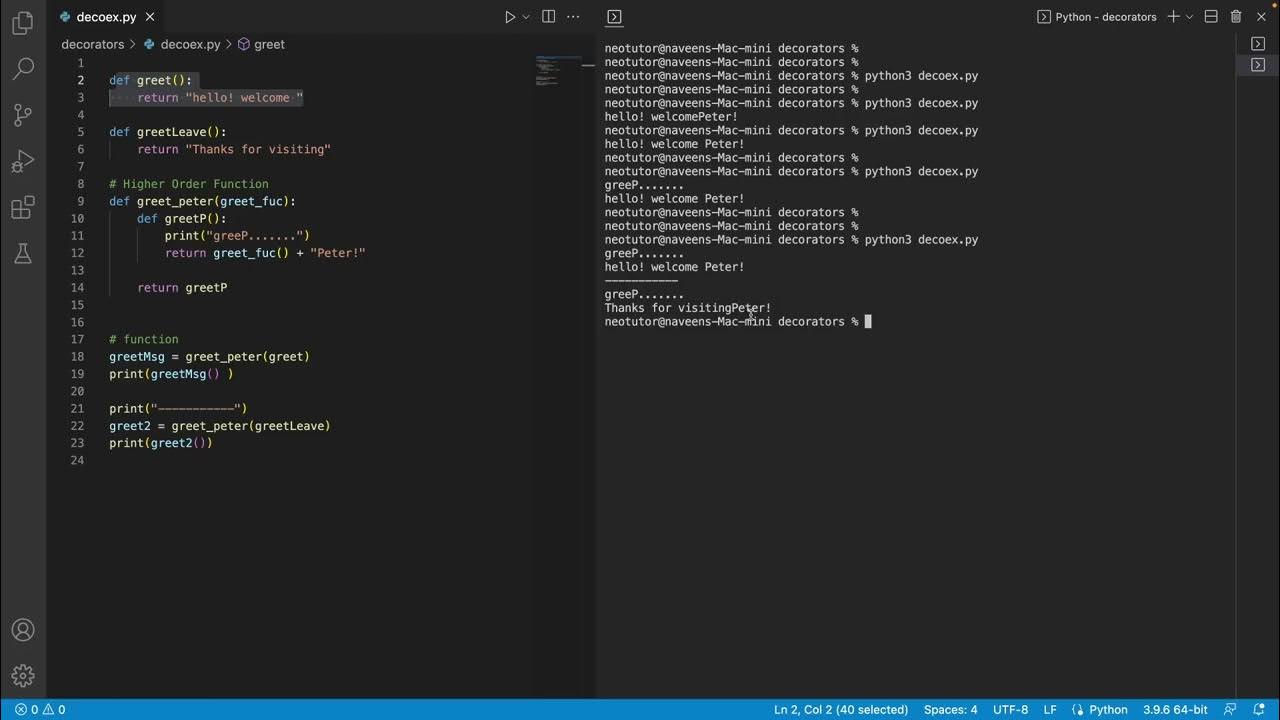Python Decorators: When and Why to Use Them?

When learning Python, you've probably come across the term "decorators" at some point. These are a versatile and powerful feature that allows developers to modify or enhance functions or classes without altering their core code. Understanding when and why to use decorators can significantly elevate your Python programming skills and help you write cleaner, more modular, and extensible code.
What Are Python Decorators?

Decorators in Python are essentially syntactic sugar for functions that wrap around other functions. Here’s a basic idea:
- They are written using the
@decorator_namesyntax, placed before the function or method they decorate. - They take a function as an argument and return a function, often after modifying or enhancing the original function in some way.
Here’s a simple example to illustrate how a decorator works:
def my_decorator(func): def wrapper(): print(“Something is happening before the function is called.”) func() print(“Something is happening after the function is called.”) return wrapper@my_decorator def say_hello(): print(“Hello!”)
say_hello()
This example will print the text before and after the function say_hello() is executed.
When Should You Use Decorators?

Decorators become particularly useful in several common scenarios:
- Logging and Debugging: To log function calls, execution times, or trace variable changes.
- Authorization/Authentication: To check permissions or ensure users are authenticated before executing the function.
- Memoization: To cache results of expensive function calls.
- Timing Functions: To measure how long a function takes to execute.
- Modifying Parameters: To add default arguments, change existing ones, or prepare data before the function call.
- Aspect-Oriented Programming: Implementing cross-cutting concerns like transactions, error handling, or monitoring.
Why Use Decorators?

There are several compelling reasons to use decorators:
- Code Reusability: Decorators allow you to add behaviors to many functions with just one implementation.
- Clean Code: They help keep the core functionality of your functions clean by segregating additional behavior or functionality.
- Metaprogramming: With decorators, you can write programs that write or modify other parts of your code at runtime.
- Less Boilerplate: Instead of repeating the same code in multiple functions, you encapsulate it within a decorator.
- Aspect-Oriented Programming: They facilitate cleaner and more manageable code when dealing with aspects that cut across multiple modules.
Creating Your Own Decorators

Creating decorators isn’t as complex as it might seem:
Simple Decorator

Let’s create a decorator to time how long a function takes:
import timedef timeit_decorator(func): def wrapper(*args, kwargs): start_time = time.time() result = func(*args, kwargs) end_time = time.time() print(f”{func.name} took {end_time - start_time:.5f} seconds to run.“) return result return wrapper
@timeit_decorator def slow_function(): time.sleep(3) # Simulating a slow function
slow_function()
Parameterized Decorators

Decorators can also accept parameters, making them even more flexible:
def repeat(num_times): def decorator(func): def wrapper(*args, kwargs): for _ in range(num_times): func(*args, kwargs) return wrapper return decorator@repeat(3) def print_hello(): print(“Hello!”)
print_hello()
Decorator with Arguments and Context

Sometimes, you might need to keep track of some context or modify function arguments:
def decorate_with_counter(func): counter = 0 def wrapper(*args, kwargs): nonlocal counter counter += 1 print(f”Called {func.name} {counter} times”) return func(*args, kwargs) return wrapper@decorate_with_counter def say_hi(name): print(f”Hi {name}!“)
say_hi(“Alice”) say_hi(“Bob”)
✨ Note: Decorators can modify the behavior of your functions or methods by adding pre- or post-execution steps, thus allowing for the implementation of cross-cutting concerns without scattering code throughout your project.
Understanding Decorator Composition and Order

One of the advanced features of decorators is the ability to stack multiple decorators. The order in which you apply decorators matters significantly:
@decorator1
@decorator2
def func():
print(“Hello World!”)
Here, func() will be decorated by decorator2 first and then by decorator1.
Real-World Applications

Decorators aren’t just academic; they’re used extensively in libraries and frameworks:
- Flask Routes: Flask uses decorators to bind URL patterns to functions.
- Debugging Tools: Tools like Django Debug Toolbar utilize decorators to provide debugging information.
- Event Handling in PyQt or wxPython: Where signals are connected to slots using decorators.
- APIs and Restful Services: Decorators for authentication, rate limiting, or response modification in frameworks like FastAPI.
Summing up, Python decorators provide an elegant way to dynamically alter the behavior of functions and methods without changing their source code. They promote code modularity, enhance readability, and allow for the implementation of cross-cutting concerns in a clean, reusable manner. Whether for logging, authentication, caching, or any other form of aspect-oriented programming, decorators are a must-have tool in the Python developer's toolkit, enabling the creation of more sophisticated and maintainable software.
What are some common use cases for Python decorators?

+
Common use cases include logging, timing functions, memoization, authentication/authorization, argument validation, or even creating class methods or properties.
Can you stack multiple decorators on a single function?

+
Yes, you can stack decorators. The order in which they are applied matters; decorators are executed from the bottom up.
How do decorators affect function introspection?

+
Decorators can change how a function is viewed through introspection (e.g., using help() or dir()). Use the functools.wraps decorator to preserve original function metadata.



